Ruth Barron, Ca. Early 1930s (Source: Kille)
 |
Ruth Barron signed the Airfield Register on Thursday, August 14, 1930 at 6:40 PM. She was flying Buhl Air Sedan NC5860 carrying Bob Lloyd as passenger. She and her passenger were northwestbound from Douglas, AZ, probably on their way to Long Beach, CA for the beginning of the 1930 Women's Class A Pacific Derby, which started on August 18th.
Her Buhl (Model CA-3C, S/N 28, manufactured in 1928) is still registered with the FAA. As of the upload date of this page it was owned by a gentleman in Riverside, CA.
Ruth Barron was born in Rochester, NY April 13, 1910 and educated at the Knox Boarding School, Cooperstown, NY; Livingston Park Seminary, Rochester, NY and the Birmingham (PA) Finishing School. She was niece of the tenor Baron Berthald of the Metropolitan Opera Company.
Ruth Barron, Rochester, NY Airport, August, 1934 (Source: Kalina)
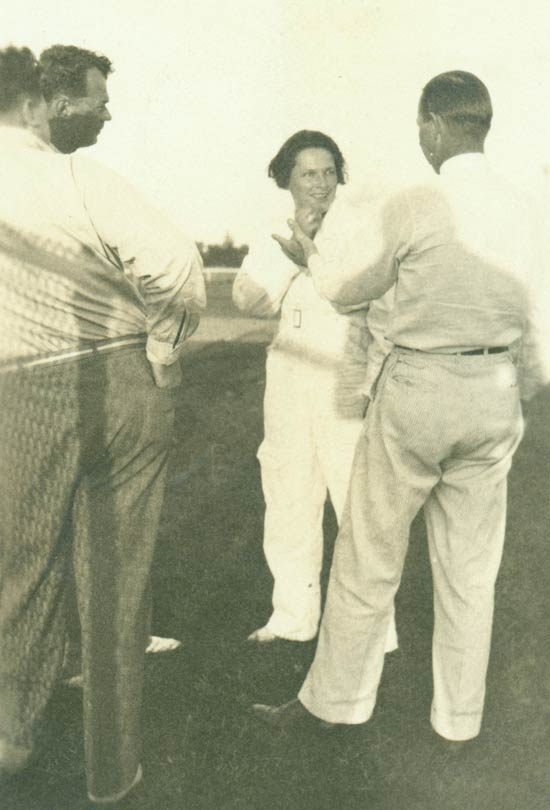 |
She was a noted swimmer and won several cups in competitions. She received her flight instruction at Leroy, NY during April, 1929. She was quick to get into the swing of aerial competition. The New York Times of July 29, 1929 cites her preparations for entry into an endurance flight at Boston, MA. There was no followup in her NASM biographical file (cited, left sidebar) as to her results, however.
In 1930 she was an entrant in the Woman's Pacific Air Derby, which started at Long Beach, CA. Although she finished the Derby at Chicago, she was forced down due to motor trouble in the mountains near Phoenix, AZ. By the time she could fix the problem, refuel and clear a runway for departure, she was penalized 17 hours. As of 1932, she held Transport Pilot license 31749.
During May, 1931, she traveled to Japan to aid preparations for the trans-Pacific flight attempt of Thomas Ash, Jr. The flight was canceled because of weather, but Barron wasted no time moving on with her life. See the next image, below.
The Washington Evening Star of January 20, 1932 announces her wedding to William Franklyn (note the misspelling in the article) Nason, U.S. Vice Consul in Japan (see additional information about him at the bottom of this page).
Ruth Barron Wedding, 1932
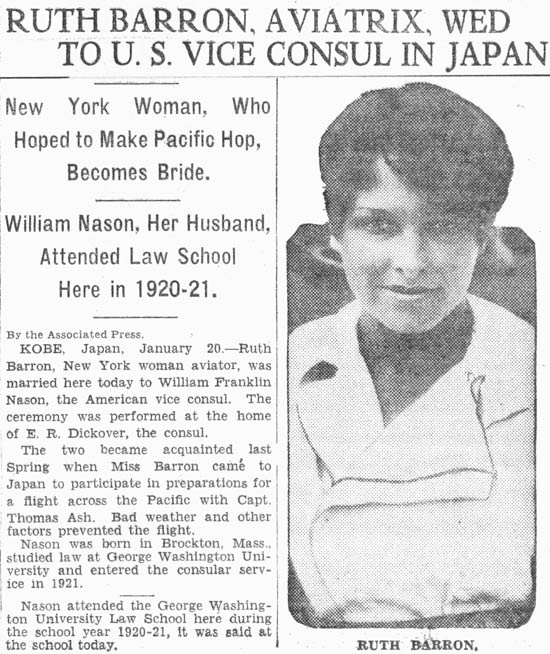 |
Below, Ruth Barron (L) with three of her contemporaries dated November 8, 1935. The airplane is Ingalls' Orion 9E, NC14222 (not in the Register). Margaret Perry is the only other Register pilot, landing Tucson April 5, 1929.
Ruth Barron (L), With Laura Ingalls, Peggy Remey and Margaret (Perry) Cooper, November 8, 1933
(Source: Kalina)
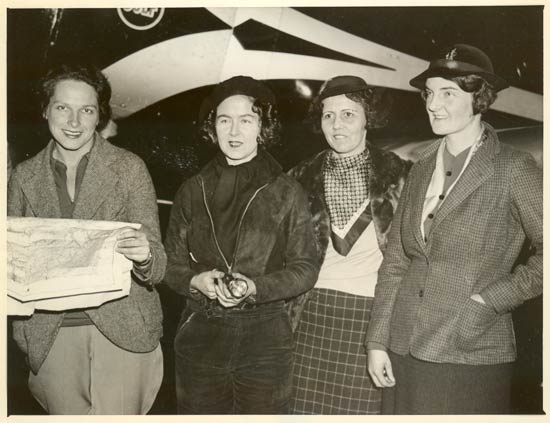 |
Below, the annotation on the back of the image above. November would have been a risky time for a transcontinental event, given the probablility of bad weather that time of year. Note Ingalls' flashlight.
Image Annotation, Enlarged
(Source: Kalina)
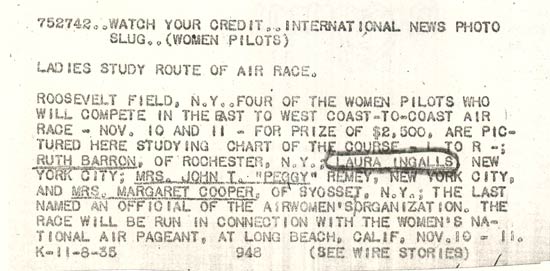 |
Monocoupe NC501W, Rochester, NY Airport, August, 1934
(Source: Kalina)
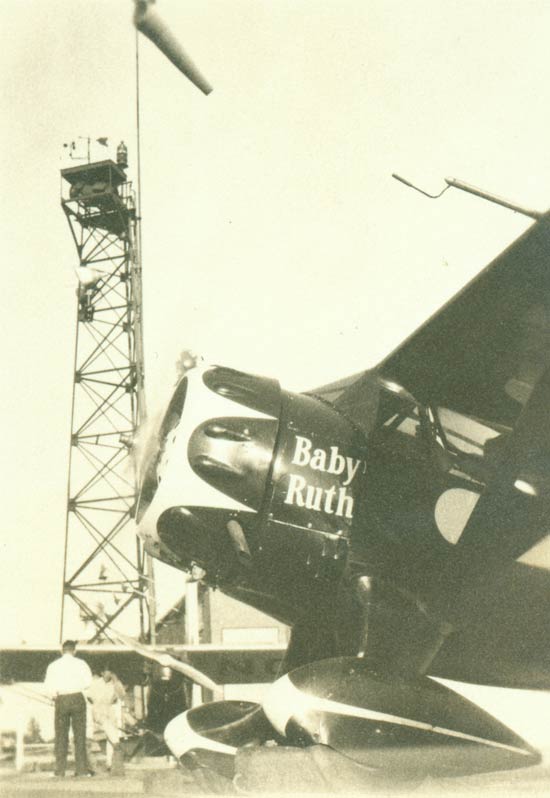 |
Image donor Tim Kalina states, "I recently purchased two old, original photos. One photo is of pilot Ruth Barron [top image on this page] and the other photo is of her Monocoupe NC501W [right]. ... Both photos came out of an old photo album of planes at the Rochester, NY Airport. NC501W was originally owned and raced by Johnny Livingston who had one win with it in the 1932 NAR cross country race. Livingston then sold the 'coupe to Jack Wright who entered it in the 1934 McRobertson Centenary Air Race from England to Australia. Wright had to quit the race in India with mechanical troubles. For the race the 'coupe was painted red, white and blue and named 'Baby Ruth' (the candy company was a part sponsor). Ruth Barron purchased the 'coupe in 1935. Barron died on July 3, 1936 in this plane when it caught fire while in flight. Barron was a chain smoker and it was believed that the fire was caused by one of her cigarettes...." Although other sources attribute the fire to an overheated engine.
The Monocoupe 501W does not appear in any of our Registers. However, compare it with John Wood's Waco NX5533. His airplane was also sponsored by the candy company and was painted with the "Baby Ruth" brand name.
A cousin of Vice Consul Nason contacted me via email February 29, 2008 and March 6, 2008 and provides two news articles regarding Nason and Barron. Further to Ruth's death, the Brockton (MA) Enterprise of Monday July 6,1936 reports, "Ruth Barron Nason young woman flier who died tragically when her plane burst into flames as she was about to land at Omaha, Neb. was the wife of William Franklin Nason, son of Mr. & Mrs. Bradford Nason,114 Newbury St. this city. Young Mrs. Nason who was well known as both aviatrix and actress was horribly burned to death when her plane a single cabin Warner powered Monocoupe caught fire and crashed. Rescuers labored almost two hours to extricate the body which was so charred that tentative indentification had to be made from salvaged pictures and papers. The plane was one in which Mrs. Nason left Rochester, NY last Wednesday for Denver, Col. to compete in air races. Mrs. Nason learned to fly in 1929 and the following year won the first lap of the womens air derby from Long Beach, Cal. to Chicago, but was forced down by motor trouble in Airzona. In 1931 she went to Japan with Capt. Thomas Ash, determined to be the first woman to fly the Pacific. Bad weather prevented the attempt but in Kobe she met and married William Franklin Nason who at that time was American Vice Consul at Koebe [sic]. He has since resigned from the consular service."
Nason was an accomplished gentleman. His relative says about him, "Her [Ruth's] spouse died May 1,1954 in Washington DC.... [He was a] Native of Brockton [MA] and served in the Navy Dept. in Washington, DC before retiring because of ill heath."
Further, from another local news obituary in the Brockton Enterprise, "On April 23,1921, he was appointed student interpreter in Japan. Two years later he was promoted to vice consul at Yokohama and March 15,1924 was transferred to Mukden. He was one of the youngest men ever to reach a full consulship serving as a career man in Formosa, Kobe and other large ports. He was in Yokohama at the time of the great earthquake, Sept. 1,1923, barely escaping with his life when the consulate collapsed and killed several at their desks. His wife the former Ruth Wells Barron of New York lost her life in a plane accident in 1936. Surviving are his mother Mrs. Edith J. Nason, 21 Wilson St., Brockton; two brothers Ralph A. Nason of Lexington and Howard A. Nason of Lac du Falmbeau, Wis."
Nason was born Nov 13,1897 as William Franklyn Nason. Note the difference in spelling of his middle name in the newspaper article quoted above. He is buried with his parents and shares the same gravestone.
---o0o---
Rochester Democrat and Chronicle, July 4, 1936 (Source: Benjamin)
 |
Update of 07/21/10 Photograph, left, is of the front page of the Rochester (NY) Democrat and Chronicle of July 4, 1936.
This photo and the news article transcriptions shown below, are shared with us by David Benjamin, whose interesting Web site about Rochester, NY history is at the link.
To orient you to this news, the first transcription is of the article headlined at far right in the photo, next to the photo of Barron.
RUTH NASON TRAPPED BY PLANE BLAZE
Ship Dives, Hits Near Nebraska Airport
Rochester Democrat and Chronicle July 4, 1936
"Ruth Barron Nason, pretty, nationally known Rochester aviator was killed while trying to land her plane that had caught fire near Omaha, Nebraska. Only 25 years old, she had been flying for eight years.
"Spectators, according to the dispatches, said she flew her ship over the western field, apparently waiting for another plane to land before setting down her ship. At an altitude estimated to be 800 feet, the plane burst into flames and nose dived into the ground. The body was burned beyond recognition. Identification was established by a telegram found in the wreckage addressed to Ruth Barron, inviting her to participate in air races to be held in conjunction with the national balloon race in Denver today.
PILOTS TOUCHED DEEPLY
"Rochester pilots, deeply touched at news that death had claimed one who had flown with them for many years, were at a loss to explain how the plane might have caught fire. One witness, dispatches said, declared that while he was watching the plane, he saw the fire start at the back of the cabin.
"The aviatrix visited the municipal airport in Indianapolis Thursday. Of the air races at Denver, she said if she didn’t win an event, 'It will be because somebody else out flew me.'
"With a deep-seated love for planes and an apt hand on the controls, Mrs. Nason climbed to national fame in a few short years. She lived with her parents, Mr. and Mrs. William Barron, 100 Ferris Street, in the city.
"She took instruction in 1928 from Lt. Otis Edgerton, then stationed at the D-W Airport in LeRoy and in less than two years she was flying so well that she left for the West Coast.
PLACED THIRD IN DERBY
"She did commercial flying in Hollywood, and in 1930 drew national acclaim by setting her plane down safely on the Arizona desert when she ran out of gas during the Women’s Air Derby. At that her 'lapped' time placed her in third place.
"Midway in her flying career, Miss Barron paused for a romantic marriage. In 1931 she left commercial flying and racing in Hollywood and with Capt. Thomas Ash went to Tokyo, determine to be the first woman to fly the Pacific. They had no plane, but finally procured one. In Japan, Miss Barron met and was married to William Franklin [sic] Nason, then American consul in Kobe. Capt. Ash promptly called off the flight. She has since separated from Nason.
FLEW OVER JAPAN
"In Japan, she was granted the only foreigner’s license up to that time to fly in the country. Even then she was escorted by a Japanese army plane through the fortified zones of the island country whenever she went aloft.
"She returned to Rochester in 1934 and broke into the headlines by coming safely through two forced landings within 24 hours of each other in the Albany area. Newspaper men at the time scoured the countryside, seeking her until she was reported safe. Making forced landings safely at night, and taking off from such rough fields as cow pastures was 'just part of the game' for the girl.
"Last summer she thrilled crowds during a air show by presenting a 15-minute stunting program. Then she left, attended by considerable publicity for the Cleveland Air Races. Her chances to capture women’s championships were so good her stock soared. But unable to refrain from a spontaneous exhibition of stunting, she was grounded and forced to watch the races from the spectator seats.
LEFT HERE TUESDAY
"Flyers at Municipal Airport here disclosed last night that until only a week ago, the aviatrix had apparently lost all interest in flying. For months she had not been at the airport and her plane was ‘under wraps.'
"Then, apparently upon receipt of the invitation to Denver, she went to the airport a week ago and tested the plane in a series of short hops. Tuesday morning, with a confident grin and a wave of her gloved hand to Airport attendants, she roared aloft and pointed the nose of her plane westward.
"But just as the plane faded into the distance, many flyers shook their heads dubiously. It had been an 'open secret' for a year at the airport that most flyers believed the daring young woman was playing with fire by handling that particular airplane, a clipped wing monocoupe. It was and out-and-out racing plane.
BIG MONEY PLANE
"The history of the plane is a romantic one. It was once considered the biggest money-making airplane in the country. At that time, John Livingston of St. Louis was its pilot.
"Livingston sold it to Jack Wright of Utica, who entered the London to Australia air derby and was well among the leaders when he landed in Persia and became entangled with the government. Later, after settling his difficulties, Wright flew to Australia.
"Wright sold the plane a year ago to Mrs. Nason. Originally the plane was a 115 horsepower Warner monocoupe, but the Utica racing pilot had clipped the wings and tail surface, installed a 145 horsepower motor, and made it a 'Flying Bullet.'
SEA HOP HER DREAM
"Never did Mrs. Nason quite abandon her dream of a trans-Pacific sea hop. Less than a year ago, several local flyers helped her in an effort to find a suitable plane. At that time, she was happy, but uncommunicative, merely letting it be generally understood that she had found a backer. Later she announced it was 'all off.' She had dreamed of a Japan to San Francisco flight, non-stop." |
This next transcription is from the column in the photo above that is just below Barron's left leg.
SORROW GRIPS BARRON HOME
Rochester Democrat and Chronicle, July 4, 1936
"Flowers are blooming in an unfinished rock garden in the rear of the Barron home at 100 Ferris Street. They were planted there carefully, tenderly, by Ruth Barron, who worked almost daily since early spring, digging, carrying stones, excavating a fish pond and building a stone fireplace to beautify the grounds around her home.
"She was doing it, too, in the hope 'It would take off a few pounds.' She expected to come back within a week or two to finish building the fish pond. Probably it will never be finished. Her father, William W. Barron is just convalescing from an attack of pneumonia during which doctors several times gave up hope for his life.
"He didn’t know, last night that Ruth had been killed. Neighbors who carried the news of the crash to the family feared to tell him on account of his delicate health. A reporter who went to the home with the news didn’t tell him, either. Ruth had been seriously injured, he knew, as he sat, fingering his cane nervously; saying nothing, only waiting further word from his daughter.
"As the reporter left, he pushed himself out of his car, a tall, gray haired figure, and extended his hand.
'Thank you so very much for coming,' he said. His grip was firm, his tone gracious. Mrs. Barron, looking not much older than her daughter, knew Ruth was dead. She grasped at the last straw of hope. 'Is it really true?' she whispered to the reporter, as she bit her handkerchief in an effort to keep back the tears. Her eyes were red. 'It can’t be so. I just can’t believe it,' she said to the reporter as he left. |
Ruth Barron's Wrecked Monocoupe, July, 1936 (Source: Benjamin)
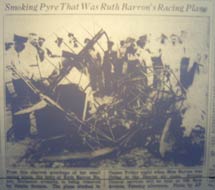 |
At right, an image of the wreck of Ruth Barron's Monocoupe at Omaha.
Below are articles that appeared in later editions of the Democrat and Chronicle. the first one conjectures that the fire was caused by an overheated engine. This conflicts with the witness observation, above, that the fire appeared to have originated at the, "rear of the cabin." That would support the dropped cigarette as a source of the fire.
PLANE DEATH CAUSE CITED
Motor Overheated In Ruth Barron’s Racing Ship
Rochester Democrat and Chronicle July 5, 1936
"An overheated motor in her small racing airplane yesterday was blamed for the death of Ruth Barron Nason, Rochester’s best known aviatrix, at the Omaha, Neb. airport Friday night. Her grief-stricken parents, Mr. and Mrs. William Barron of 100 Ferris Street, with whom she lived, await the arrival of her body tomorrow morning.
"The nationally known 25-year-old Rochester flyer was enroute to Denver to compete in air races in conjunction with the national balloon race when her ship circled the Municipal Airport at Omaha, 800 feet up, suddenly became enveloped in flames and burned her to death as it nose-dived to earth. She took off from Rochester last Tuesday.
BELIEVE WAY LOST
"Charles Doyle, Nebraska Aeronautics Commission secretary advanced the overheated motor theory, according to the Associated Press, after Federal Air Commerce Bureau officials from Kansas City assumed charge of the attempt to learn what caused the accident.
"Miss Barron left Kansas City Friday afternoon for Denver, Doyle said, she probably became confused in the air and lost her way following the Missouri river to Omaha, thinking she was following the Kaw River in Kansas toward Denver. Late in the day, she landed at Fort Creek, Army Post, south of Omaha, where, Doyle said, soldiers noted the motor was overheated and sputtering oil. Mechanics there told her of the trouble, Doyle said.
"She took off from Fort Creek after a brief stop, however, apparently intending to fly to the Omaha Airport from which she could follow the lighted airway to Cheyenne and Denver. The pretty aviatrix’s charred body was identified by papers and pictures found near by.
FUNERAL PLANS DELAYED
"A Rochester funeral director wired a mortuary in Omaha and made plans to receive the body in Rochester tomorrow. Until then, funeral arrangements will be incomplete. Mrs. Barron’s parents were kept secluded yesterday afternoon from visitors who called to express condolences. Mr. Barron is recuperating from an attack of pneumonia.
"A veteran of eight years of flying, Miss Barron was separated from her husband, William Franklin [sic] Nason, former American vice consul in Kobe, and now believed to be in New York City.
"Miss Barron was dead before rescuers could reach the tangled mass of wreckage. They labored almost two hours to extricate the body. It was so badly burned it was immediately sealed in an airtight casket."
|
RUTH BARRON ADMITTED RISKS
Akron (OH) Beacon Journal, Helen Waterhouse July 5, 1936
"I missed death with Ruth Barron only because the Beacon Journal staff was riddled by vacations and the City Desk denied my request to fly with her to the Denver Air Show. I met Ruth Barron at the Cleveland Air Races last year and when she arrived in Akron two nights before she was killed, I went to her room at a local hotel to speak with her. I spent an entire evening here chatting over old times.
HAD TROUBLE WITH THE PLANE
"Then she went on to talk of the difficulty in handling the plane in which she was making the trip to the Rocky Mountains. She said she had a fuel problem and had to make a forced landing on a farm near Kent, Ohio. A gas line had broken and she maneuvered the ship carefully and landed it so she could tape up the fuel line
"Miss Barron told me she found it very difficult to fly the plane and watch maps at the same time and for that reason she was constantly overshooting airports. But she only laughed when I reminded her of the risks of night flying.
"In fact, Miss Barron had removed all equipment for blind flying, just before leaving Rochester, in order to lighten the machine for the Denver race. She revealed she was the only able to see out one side of the clip winged monoplane. Her flight from Rochester to Akron had been made at an altitude of only 500 feet she told me.
"I asked here why she didn’t wait to have the blind flying equipment radio removed after she arrived in Denver and she told me, 'It takes a long time to removed it, and I was afraid I wouldn’t have time before the race. '
Then she showed me the telegram which first led to the identification of the craft in Omaha after the tragedy
"She was thrilled over the fact she had been invited to compete with the cream of male air racing. She was proud of that wire and showed it to me time after time and she carried to her flaming death.
“I want to race, its in my blood. I have sacrificed everything for it.
STOOD ON OWN MERITS.
“I don’t want to be treated like a woman and have men help me. I want them to think I am a good flyer and able to take care of myself.
"''That is why I don’t try to promote backers or promote ships.' Miss Barron went on, 'Any girl can promote things. I want to earn my right to fly. And I don’t want a lot a ballyhoo.'
"Just before Miss Barron took off from Akron in her little plane, she looked at the pictures of famous aviation people who have visited Akron. She looked at the pictures of famed women flyers in the women’s aeronautical room at the municipal airport. She paused the longest over one of Florence Klinginsmith, who crashed in a national air race several years ago and at one of Millie Stinaff, Akron girl stunt pilot who fell to her death at the Akron Airport.
“'Good sports,' she commented.
"And then as she turned to go to the field to enter her plane she turned and said to me, 'If I die, I want to sob stories written.'
|
At left, flowers for aerial dispersal. At right, Ruth Barron's bier carried by six men cited in the article transcribed below.
Flowers for Aerial Dispersal, July, 1936 (Source: Benjamin)
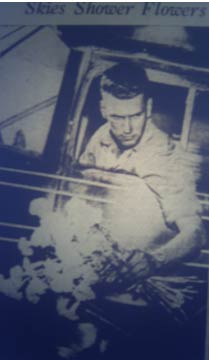 |
Bier of Ruth Barron, July, 1936 (Source: Benjamin)
 |
AVIATORS PAY LAST TRIBUTE AT GRAVE OF RUTH BARRON
Rochester Democrat and Chronicle July 7, 1936
"Planes roared over White Haven Memorial Park yesterday as six flyers bore the bier of Ruth Barron Nason to the grave. Friday night the 25-year old flyer’s plane fell in flames. Yesterday the sky she loved and the men who taught her to fly gave her the honors of courageous death in a shower of red and white carnations from a squadron of 14 planes. The pounding of the motors drowned out the low-voiced prayer of the Rev. Raymond N. Kistier and the sobs of the sorrowing parents. The spoke only of the life Ruth Barron knew.
"A crowd of approximate 200 was scattered over White Haven Park when the funeral cortege arrived. Through the blazing sun to a tent erected over the flower banked grave, six flyers carried the bier. Otto Enderton, one of the bearers, gave Ruth Barron her first flying lessons and saw her first solo. The other men, Clarence and Kent Robinson, Vincent Plamer, Arthur Lowman and Ernest Vetter, all members of the Rochester Pilots Association, where her friends.
"The ceremonies had little of the conventional in them. The bearers wore white. Mrs. William Barron, the dead Girl’s mother, walking between her husband and William Franklin [sic] Nason, wore a white hat and coat over a black and white dress. Nason was vice consul in Tokyo when he married the aviatrix. Behind them moved a little company of ten or twelve family friends, for by their wish, the ceremony at the funeral home had been confined to an intimate circle.
"But the crowd at the Park include more than usual number of curious--matrons hatless in bright frocks and children there to see the planes.
"At the earlier funeral services, which preceded those at the cemetery, Rev. Kistier recited Tennyson’s tribute to death, “Crossing the Bar.” He said in conclusion, 'Ruth Barron lived fully and richly. Her life had completed its course and she has crossed over into eternity.'
"Among the numbers floral tributes piled about the bier was a great square of flowers with a propeller in the center, the gift of the employees of Municipal Airport." |
Ruth Barron, Unmarked Grave Site, July, 2010 (Source: Benjamin)
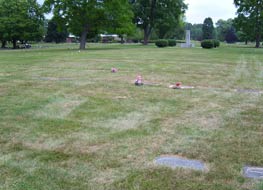 |
Mr. Benjamin further states, "I got to the Rochester Library yesterday and the Democrat and Chronicle that reported Ms. Nason's death reports she is buried in White Haven Cemetery in Pittsord, NY. Pittsford is a suburb on the east side of Rochester." Photo, left, of her grave site.
Further, Mr. Benjamin states, "She is interred in Section H, Lot 368, Grave 6 at White Haven Memorial Park, 210 Marsh Road, Pittsford, New York 14534. There are no markers on her grave."
---o0o---
As with many pages on this Web site, one thing leads to another and another. Further to NC501W, the photograph below is shared with us by site visitor John. John says about the image that it is a, "... photo of Jack Wright standing next to his (formerly John Livingston's) monocoupe NR501W, that Ruth Barron crashed in." Note "Baby Ruth" painted on the nose. John, Jr. and Walter, to whom the photo is addressed, are image donor John's father and uncle. John states further, "... my father & uncle went to an airshow as kids, where they got this pic autographed."
Jack Wright with NC501W, Ca. 1933 (Source: John)
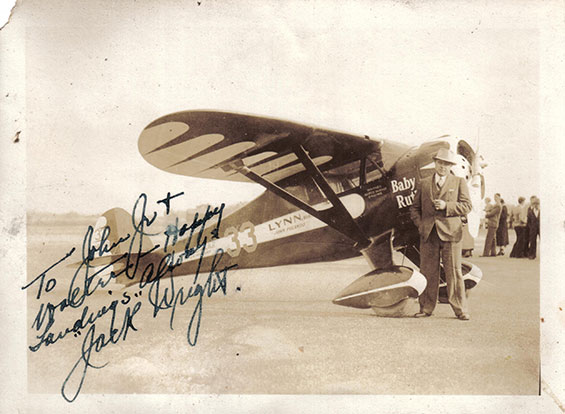 |
Painted under the window on the side of the fuselage is race number "33" and "Lynn, Mass. John Polando." Farther back on the fuselage, under the signature, are two lines that read "UTICA, N.Y. Jack Wright." For a clear view of the writing, and to hear Wright say a few words, this YouTube video shows both within the first minute.
John Polando was a long-distance racer with a good Web presence. I'll leave it to you to explore the details of his flying life. John H. "Jack" Wright "survived" the Great Depression in a variety of ways, some not legal. The Utica (NY) Daily Press of Tuesday, July 19,1938 cites Wright's management of a Works Progress Administration aircraft maintenance school. According to the article, his students were enthusiastically preparing a crashed Wedell-Williams aircraft for the 1938 Bendix Race that fall.
Utica (NY) Daily Press, February 13, 1945 (Source: John)
 |
A 1940 issue of the same newspaper headlined, "Plane County Bought in Parts Revealed Long After Crash." The article cites a scam perpetrated by Wright wherein he purchased piecemeal, on the tab of his local Oneida County's budget, parts to build up an entire airplane. The county had a law whereby any purchase over $500 had to go out on competitive bid.
So Wright bought an engine for $490, a set of wings for $400, and a fuselage and landing gear for $475. According to the article, Wright's piecemeal billing for the airplane, with no purchase over $499, enabled him to order and take delivery of a flying Fleet biplane (NC8614, S/N 35), avoiding the legal bidding process. But that wasn't all.
The plane was finally "bought" in April, 1939. Wright left the WPA operation in September (but he remained on the WPA payroll through October), with the airplane, to take a job as a flight instructor at Virginia Polytechnic Institute (VPI), Blacksburg, VA. Wright reported that he crashed the airplane enroute, leading to an investigation that revealed the scam and surprised his county's board of supervisors. The board chairman was quoted in the article, "Nothing was said about any airplane with that appropriation, and if Wright bought a plane with the money and took it with him to Virginia, he has given us a rooking." Indeed.
Another 1940 article in the same paper delved further into the scam. It is not clear that the airplane was ever wrecked, as Wright said it was. Wright sold the airplane to VPI for $600. He did turn that money over to the aviation school in Utica, as shown in a ledger entry of October 30, 1939. Because of lack of supervision, however, the title of the airplane still belonged to the Oneida County school: VPI did not legally own the airplane. The rest of the article describes the negotiations both schools held to get the title and a fair amount of cash transferred for its legal purchase. VPI owned the airplane.
Finally, an article in the Utica Daily Press of February 13, 1945 (toplines, right) described the last turn of Wright's shady dealings. He was imprisoned for embezzling $29,000 during the time he managed the VPI airport at Blacksburg. He was faced with nine indictments, five of which were discarded. He ultimately was sentenced to 4.5 years in prison. The article described his service during two world wars, and his rise to major during his brief service during WWII.
Additionally, an article about Monocoupes appeared online in Sportsman Pilot (date not clear from the Web page). It makes it clear that 501W is still alive and well. The article stated, "What happened to Johnny Livingston's 501W? A truly great empirical drag reduction expert, he modified his 110 so much for the 1932 season that he had to give up its standard category license and move into the experimental-air racing (NR) category. This was the result of having the factory install a wing reduced in span from the normal 32 feet to 23 feet and 2.5 inches. This was the first Clipwing Monocoupe. It was very fast, but had to run against pure racers that were faster still, so Johnny's only win at the 1932 National Air Races was in a cross country race. His best finish in a pylon race was third place.
Johnny sold NR501W to Jack Wright in April of 1933 and had Clyde and Eldon Cessna build him a pure racer, the CR-3A . . . but that's another story. Jack Wright continued to modify 501W and, with the help of the Monocoupe factory, subsequently had the airplane returned to the Standard category under the Group 2 approval 2-452 (7-1-33). All the subsequent six factory Clipwings would be built under that approval.
Jack Wright and long distance flyer John Polando would enter the famed England-to-Australia MacRobertson Race in 1934, but dropped out in India after incurring damage during a landing.
NC501W was sold to Ruth Barron early in 1935 and she was killed in the crash of the racer the following July 3, 1935 while on landing approach to the Omaha airport. Apparently, a fire broke out in the cabin. The Clipwing was totally destroyed in the crash, but as we know so well today, as long as the paperwork still exists a new airframe can always be built up from it. California's Jim Heim began that process of resurrection years ago, passed it on to Al Allin of Michigan and Texas, and, today, the work on 501W is being completed by Jim White of Chandler, Arizona."
---o0o---
Dossier 2.4.6
THIS PAGE UPLOADED: 02/25/08 REVISED: 02/29/08, 03/06/08, 04/11/10, 07/21/10, 11/12/13. 06/30/19
|














